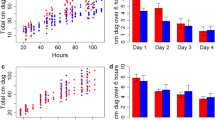Summary
The trail-laying behaviour of foragers of the antLasius niger was observed in the laboratory on a 20 cm bridge between the nest and the food source. We measured both the frequency of trail laying, as defined by the proportion of trips during which trail laying occurred, and its intensity, as defined by the number of marks laid during one bridge crossing.
Foragers do not exhibit trail-laying behaviour until a food source is discovered. Trail laying then occurs more or less equally both to and from the nest, and both its frequency and intensity decrease as the recruitment proceeds. Foragers from very small colonies less than a year old appear to have quantitatively the same trail laying behaviour as those from older and much larger colonies.
Groups of recruiters and recruits were individually marked. Their trail laying intensity was similar, both for trips to and from the nest, and for an ant's first, second, third and fourth trip. The frequency diminished rapidly with the number of trips made by each individual, and was 2–3 times higher for recruiters than for recruits, for trips both to and from the nest. Even though foragers stop marking after a variable number of passages, they continue to move between the nest and the food source, and other ants start marking. Different foragers appear to have widely different levels of trail laying, although we cannot say whether these differences are stable between different recruitments.
Trail laying is strongly affected by the foragers' position on the bridge, especially for ants returning to the nest which lay up to five times more on the segment closest to the source than that closest to the nest. Foragers on a weakly marked trail appear to mark more than those on a well-marked trail. However, this effect is weak and could partly be attributed to their lower speed.
Finally, a model using the experimental data gathered on the individuals' trail-laying behaviour reproduced satisfactorily the colony's overall trail laying.
Similar content being viewed by others
References
Arons, S., J. M. Pasteels and J. L. Deneubourg, 1989. Trail-laying behaviour during exploratory recruitment in the Argentine Ant,Iridomyrmex humilis (Mayr).Biol. Behav. 14:207–217.
Aron S., 1990. Contribution individuelle et collective dans l'exploitation du territoire chezLeptothorax unifasciatus etIridomyrmex humilis (Hymenoptera, Formicidae). P.h.D. Thesis, Université Libre de Bruxelles.
Beckers, R., S., Goss, J. L. Deneubourg and J. M. Pasteels, 1989. Colony size, communication and ant foraging strategy.Psyche 96:239.
Beckers, R., J. L. Deneubourg, S. Goss and J. M. Pasteels, 1990. Collective decision making through food recruitment.Ins. Soc. 37.
Cammaerts, M. C. and R. Cammaerts, 1980. Food recruitment strategies of the antsMyrmical sabuleti andMyrmica ruginodis.Behav. Process. 5:251–270.
Deneubourg, J. L., S. Aron, S. Goss and J. M. Pasteels, 1990. The self-organizing exploratory pattern of the Argentine ant.J. Insect Behav. 3:159–168.
Detrain, C., J. L. Deneubourg, S. Goss and Y. Quinet, 1991. Dynamics of collective exploration in the antPheidole pallidula. Psyche (in press).
Goss, S., S. Aron, J. L. Deneubourg and J. M. Pasteels, 1989. Self-organized shortcuts in the Argentine ant.Naturwissenschaften 76:579–581.
Hahn, M. and U. Maschwitz, 1985. Foraging strategies and recruitment behaviour in the European harvester antMessor rufitarsis (F.)Oecologia 68:45–51.
Hölldobler, B., 1971. Homing in the harvester antPogonomyrmex badius.Science 171:1149–1151.
Hölldobler, B., 1976. Recruitment behavior, home range orientation and territoriality in harvester ants,Pogonomyrmex.Behav. Ecol. Sociobiol. 1:3–44.
Hölldobler, B., 1981. Foraging and spatio-temporal territories in the honey antMyrmecocystus mimicus Wheeler (Hymenoptera: Formicidae).Behav. Ecol. Sociobiol. 9: 301–314.
Hölldobler, B. and M. Möglich, 1980. The foraging system ofPheidole militicida (Hymenoptera: Formicidae).Ins. Soc. 27:237–264.
Hölldobler, B. and J. F. A. Traniello, 1980. The pygidial gland and chemical recruitment communication inPachycondyla (=Termitopone) laevigata.J. Chem. Ecol. 6:883–893.
Jaffe, K., 1980. Theoretical analysis of the communication system for chemical mass recruitment in ants.J. Theor. Biol 84:589–610.
Jaffe, K. and P. E. Howse, 1979. The mass recruitment system of the leaf-cutting antAtta cephalotes (L.).J. Theor. Biol. Behav. 27:930–939.
Traniello, J. F. A., 1977. Recruitment behavior, orientation, and the organization of foraging in the antCamponotus pennsylvanicus De Geer (Hymenoptera: Formicidae).Behav. Ecol. Sociobiol. 2:61–79.
Traniello, L. F. A., 1989. Chemical trail systems, orientation, and territorial interactions in the antLasius neoniger.J. Insect Behav. 2:339–354.
Van Vorhis Key, S. E. and T. C. Baker, 1986. Observations on the trail deposition and recruitment behaviors of the Argentine antIridomyrmex humilis (Hymenoptera: Formicidae).Ann. Entomol. Soc. Am. 79:283–288.
Author information
Authors and Affiliations
Rights and permissions
About this article
Cite this article
Beckers, R., Deneubourg, J.L. & Goss, S. Trail laying behaviour during food recruitment in the antLasius niger (L.). Ins. Soc 39, 59–72 (1992). https://doi.org/10.1007/BF01240531
Received:
Revised:
Accepted:
Issue Date:
DOI: https://doi.org/10.1007/BF01240531




